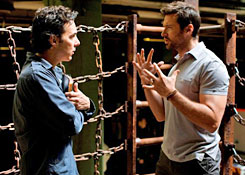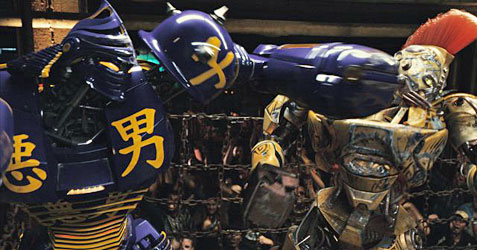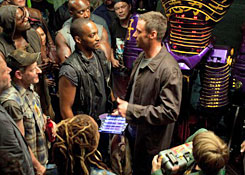
09/16/2011
Movies Home / Entertainment Channel / Bullz-Eye Home
Shawn Levy doesn't exactly have the greatest reputation among film critics and journalists (The A.V. Club even included him on its list of Directors You Didn't Know You Hated), but the first thing you notice upon meeting the man behind the "Night at the Museum" series is that he's insanely passionate about making movies. It's the kind of childlike enthusiasm for the magic of filmmaking that you'd wish every director had for his craft. But Levy is a unique brand of director, because while it's painfully obvious that he wants people to like his movies, it's only because he's so in love with them himself. That may reek of desperation, or egotism, depending on how you look at it, but if a director doesn't even like the movie he's making, then he's going to have a hard time convincing audiences to pay money to see it.
Let me back up a bit. In August 2010, Bullz-Eye was invited along with a handful of other online movie sites to attend a set visit for Levy's new film, "Real Steel." Filming had already been going on for months throughout the state of Michigan, and the final weeks of production were taking place in the metro Detroit area. Not exactly the most glamorous locale to be visiting, but between the great tax incentives and the job opportunities it's offered hundreds of unemployed Detroit natives, it's hard to argue otherwise. Levy didn't play coy about the tax incentives factoring in to his decision to shoot there, but he maintains that he was ultimately sold by the state's "beautiful but decayed environments" (like the former Highland Park Model T plant, which stands in as a Thunderdome-like fight arena), a look they wanted for the movie.
 Loosely based on Richard Matheson's short story, "Steel" – which the author also adapted for a "Twilight Zone" episode starring Lee Marvin – Levy's film takes place 10 years in the future where robot boxing has become the biggest sport in the world. Hugh Jackman stars as Charlie Keaton, a former boxer who must now scrape by as a fight promoter for the very things that ended his career. But when he's reunited with his estranged 10-year-old son, Max (Dakota Goyo), they discover an old sparring bot named Atom in the junkyard that could turn Charlie's luck around and bring him closer to his son. And while Jackman agrees that Charlie's actions are pretty reprehensible at the beginning of the movie, he's adamant that the audience will still root for him because you'll understand where he's coming from.
Loosely based on Richard Matheson's short story, "Steel" – which the author also adapted for a "Twilight Zone" episode starring Lee Marvin – Levy's film takes place 10 years in the future where robot boxing has become the biggest sport in the world. Hugh Jackman stars as Charlie Keaton, a former boxer who must now scrape by as a fight promoter for the very things that ended his career. But when he's reunited with his estranged 10-year-old son, Max (Dakota Goyo), they discover an old sparring bot named Atom in the junkyard that could turn Charlie's luck around and bring him closer to his son. And while Jackman agrees that Charlie's actions are pretty reprehensible at the beginning of the movie, he's adamant that the audience will still root for him because you'll understand where he's coming from.
After a brief introduction by Levy and Jackman, the pair was called back to the futuristic boxing ring sitting inside Cobo Arena to shoot a scene while we sat down to watch via monitor. To be honest, it wasn't very exciting, as there was no dialogue and the scene in question featured a major spoiler from the end of the film, but we did get a pretty good idea of how the practical robots were being utilized. 19 different robots were built in total by Legacy Effects (formerly Stan Winston Studios), and though a majority of the action in the film will feature CG versions of those robots, you might be surprised to learn just how much they were able to accomplish using the practical models.
In the scene we witnessed, Jackman was joined by Dakota Goyo and the hero robot, Atom, as they celebrated their latest win. Cobbled together using spare parts, Atom is every bit the junkyard robot he's described as – with a face that resembles a fencing mask, bronze hands that look like boxing gloves, and a whirring motor in his back. It's a pretty cool thing to see up-close, but I was more impressed by the way in which Jackman handled himself around Goyo in between filming. He really seems to have a good rapport with his young co-star, and when asked about what it was like working with a child actor, he was incredibly flattering:
"It's funny, because I have a 10-year-old son… so there's an obvious connection, which is very easy for me as an actor, but Dakota is a special boy – on screen and off screen. He's really something else. He's a really talented actor and I can ad-lib with him and he can give it right back. He floors the crew constantly. And he's like an old soul. I mean, he's going to be, I would predict, a very big movie star. I'm pretty sure this will do very big things for him."

In addition to that scene, we were also shown a previously filmed sequence that takes place earlier in the film where Charlie and Max go to an underground arena (the aforementioned Highland Park) to enter their first robot, the Shogun-inspired Noisy Boy, into a title fight. Though the sequence was an unfinished mix of live action and early visual effects, it helped show how Levy plans on integrating the practical robots into the movie. Everything else will be done using CG, either with men in motion capture suits on stilts or previously recorded mo-cap footage for the fights.
The mo-cap in particular is interesting not only because the boxing sequences were overseen by Sugar Ray Leonard, but because Levy is using James Cameron's "Avatar" technology to film it. Using a camera called Simulcam B, Levy was able to motion capture real boxers performing the choreographed fights and then convert them into their CG avatars. But where Cameron's film took virtual creatures and put them into a virtual world, Levy has been able to go to real locations and insert the robot avatars into those environments in real time. By seamlessly integrating CG robots into a live-action shot in-camera, it gives the director more freedom to get the shot he wants without having to worry about someone from a visual effects company painting it in later. Jackman was especially enthusiastic about how the technology affects the process:
"I mean, we did one fight sequence and we were here for six days. And on 'X-Men," that would have been a month – at least three weeks, probably with two units. This is one unit and it's so specific, and more importantly than anything, Shawn is in control of everything. It's way more efficient and so much better for storytelling."
There's still a lot you need to know about "Real Steel" before you pass any judgment on the film, like Levy's insistence that it's not a science fiction movie. In fact, when the story begins, the world as we know it is relatively unchanged apart from the meteoric rise of robot boxing. There are no other robots present in society, and the ones that do fight don't have any personality apart from the individual aesthetics in their design. Production designer Tom Meyer spoke to us about his approach to creating the look of the film and reaffirms that it's really about a world that is familiar to us:
"A blade of grass is a blade of grass. It was the same a million years ago and it will be the same a million years from now. So if I put a robot in a field, who's to say that's the future, the past, the present, or any time? And then the audience is free to loosen up and not feel like, 'Okay, what's going on? It doesn't make any sense.' In creating that world, I wanted to basically take away those distractions from the audience and create designs and robots that were kind of understandable."
 But while you may not see any flying cars in the background, you will notice subtle details acknowledging the brief jump in time. The robots, however, are controlled by simple remote devices and headsets, and though we got a look at how they function in the film, Atom's rare shadow feature – which allows the handler to pre-program moves into his memory – wasn't revealed in the sizzle reel that Levy and editor Dean Zimmerman showed to us. The teaser itself focused pretty heavily on the robot facet of the film, but Levy was quick to point out that "Real Steel" is most definitely not a robot boxing movie, but a sports drama that revolves around the relationship between father, son and machine.
But while you may not see any flying cars in the background, you will notice subtle details acknowledging the brief jump in time. The robots, however, are controlled by simple remote devices and headsets, and though we got a look at how they function in the film, Atom's rare shadow feature – which allows the handler to pre-program moves into his memory – wasn't revealed in the sizzle reel that Levy and editor Dean Zimmerman showed to us. The teaser itself focused pretty heavily on the robot facet of the film, but Levy was quick to point out that "Real Steel" is most definitely not a robot boxing movie, but a sports drama that revolves around the relationship between father, son and machine.
When he was originally approached by Steven Spielberg to direct the film, Levy claims that he was adamant about not wanting to do another robot fetish movie, because "Michael Bay's done it well [and] Cameron's done it well." The only way doing a robot movie in 2011 was going to be fresh was to make it unabashedly humanistic and emotional like Pixar's "Wall-E." Although he went back and re-watched several classic boxing films like "Raging Bull," "The Champ," and all of the Rocky movies to prepare, he's also noticed that there's a big "E.T." component to the story in that it's about a boy whose personal life is broken and who makes a redemptive connection with another being. Both Levy and Jackman also listed "Paper Moon" as a major influence and feel like their movie has the same kind of shaping dynamic.
And no matter how cool the robot boxing scenes may look, this is what ultimately sold me on the potential of "Real Steel." Because if Levy can deliver a similar relationship between father and son that the real-life father-daughter duo of Ryan and Tatum O'Neal had in Peter Bogdanovich's 1973 classic, then he might just be on his way to winning over some of his biggest critics.
"Real Steel" opens in theaters on October 7, 2011.
You can follow us on Twitter and Facebook for content updates. Also, sign up for our email list for weekly updates and check us out on Google+ as well.











